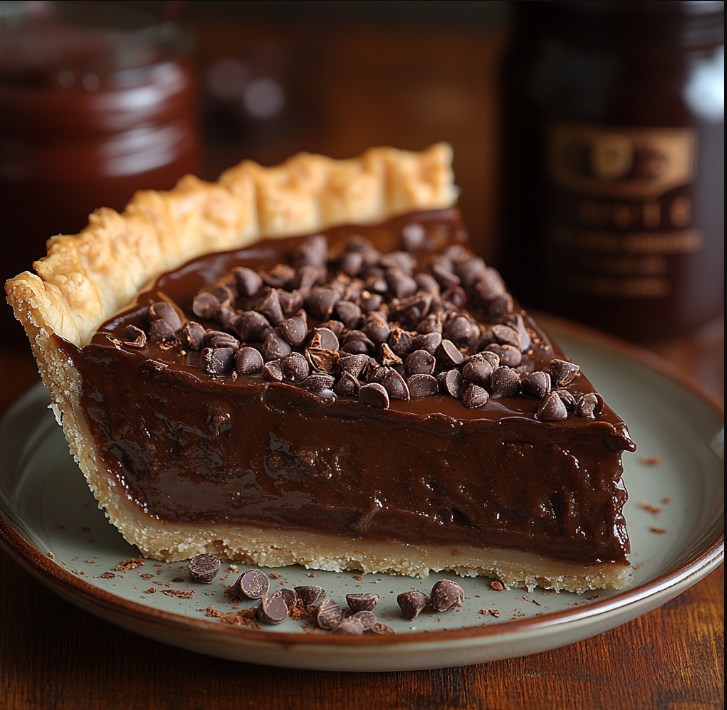A runny chocolate pie can be a major disappointment after putting in the effort to make a rich, creamy dessert. While chocolate pie is known for its smooth, luscious filling, sometimes it fails to set properly. From thickening agents to cooking techniques, several factors may be preventing your chocolate pie from achieving the perfect texture. In this guide, we’ll explore common reasons why your pie won’t set and how to fix the issue.
Common Causes of a Chocolate Pie Not Setting
There are a few reasons why your chocolate pie might not be setting correctly. Let’s take a closer look at the most common problems.
Incorrect Thickening Agents
One of the main reasons for a runny chocolate pie is the incorrect use of thickening agents like cornstarch. Cornstarch needs to be cooked at the right temperature to activate its thickening properties. Without enough cornstarch or proper heating, your filling will stay runny. To better understand how to thicken pie fillings, check out this helpful guide on how to thicken coconut cream pie filling, which provides tips applicable to all types of pies.
Not Cooking the Filling Long Enough
Another common cause is undercooking the filling. If the mixture isn’t cooked long enough, the thickening agents won’t fully activate, leaving the filling too loose. It’s important to cook your pie filling over medium heat while stirring constantly until it reaches a pudding-like consistency. For a similar issue with different desserts, you can refer to the why does my coconut cream pie get watery guide, which also discusses how to properly set a filling.

The Role of Heat in Setting Chocolate Pie
Temperature plays a key role in setting your pie filling. Cooking the filling at the correct heat ensures that the thickening agents work effectively.
Achieving the Right Temperature
For cornstarch or egg yolks to properly set the filling, the mixture needs to reach the right temperature. If the heat is too low, the pie won’t set, and if it’s too high, it can break down the thickening agents. Maintaining medium heat and stirring constantly is essential for ensuring the filling reaches the correct consistency.
Boiling vs. Simmering
Many home bakers make the mistake of boiling the filling to thicken it faster. However, this can cause the mixture to break down and become too thin. It’s better to simmer the filling over gentle heat to allow it to thicken naturally. For more information on proper heating techniques, refer to the recipe for chocolate pie on Valeria Recipes.
Understanding Thickening Agents
The type of thickening agent you use in your chocolate pie is critical to its final texture.
Cornstarch and Its Function
Cornstarch is one of the most common thickeners in pie fillings. It binds with the liquid ingredients, creating a smooth and firm filling when cooked properly. However, if the cornstarch isn’t fully cooked, it won’t activate, and your pie will remain runny. Make sure the mixture thickens before removing it from the heat.
Alternatives to Cornstarch
If you prefer not to use cornstarch, there are several alternatives that can work just as well. Arrowroot, tapioca starch, and even flour can thicken the filling, but each requires slightly different methods. For a gluten-free alternative, consider using arrowroot, which also works well in pies like lemon cream cheese pie.
The Role of Eggs in Custard Filling
Egg yolks are essential in custard-based pies like chocolate pie because they help create a rich, firm texture. However, if they aren’t tempered correctly, they can curdle or fail to thicken the filling. Make sure to temper the eggs by whisking them with a small amount of the hot filling before adding them back into the mixture.

Tips for Perfecting Your Chocolate Pie Filling
If you want to ensure your chocolate pie sets perfectly every time, follow these key steps.
Step-by-Step Process for a Custard-Based Filling
- Whisk Dry Ingredients: Combine sugar, cornstarch, and a pinch of salt in a saucepan.
- Add Wet Ingredients Gradually: Slowly whisk in milk and egg yolks to create a smooth mixture.
- Cook Until Thickened: Heat the mixture over medium heat, stirring constantly until it thickens into a pudding-like consistency.
- Cool the Filling: After thickening, pour the filling into your pie crust and allow it to cool at room temperature before refrigerating.
Avoiding Common Mistakes
- Constant Stirring: Keep stirring the mixture to avoid lumps and ensure even thickening.
- Temperature Control: Overcooking the filling can cause it to lose its thickening power. Use a thermometer to maintain the right temperature during cooking.
Cooling and Setting the Pie
Even after you’ve cooked your filling correctly, it’s crucial to allow the pie to cool and set properly.
Why Cooling is Critical
Once the pie is removed from the heat, it needs to cool slowly at room temperature for at least an hour before being refrigerated. Rapid cooling can prevent the pie from setting evenly, resulting in a runny texture. For more cooling tips, you can read this article on why pies get watery, which provides additional insights on setting pie fillings.
Ideal Cooling Time
For the best results, refrigerate your pie for at least 4–6 hours or overnight. This ensures that the filling firms up and slices cleanly when served.

FAQs: Why Won’t My Chocolate Pie Set?
Why is my chocolate pie still runny after cooling?
If your pie is still runny after cooling, it may be due to undercooking the filling or not using enough thickening agents like cornstarch or eggs.
How do I thicken a pie filling that won’t set?
You can thicken the filling by reheating it and adding more cornstarch. Make sure to cook it long enough for the thickener to activate fully.
Can I fix a runny chocolate pie after baking?
Unfortunately, once the pie is baked, fixing a runny filling is difficult. You can try refrigerating it longer to help it firm up.
What’s the best thickening agent for chocolate pie?
Cornstarch is the most common thickening agent, but alternatives like arrowroot or tapioca starch work as well.
Is it possible to undercook a chocolate pie?
Yes, undercooking the filling is a common reason for a pie not setting. Make sure to cook the filling long enough for the thickening agents to activate fully.
Conclusion
Achieving a perfectly set chocolate pie requires the right balance of thickening agents, cooking time, and cooling. By following the steps outlined in this guide and paying attention to the use of ingredients like cornstarch and eggs, you’ll be able to create a pie that’s rich, creamy, and sets beautifully. For more pie-related tips and recipes, don’t forget to check out this chocolate pie recipe and explore more delicious options.
